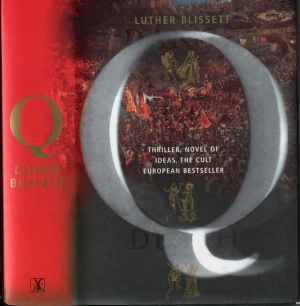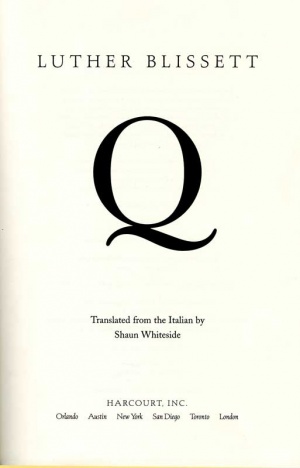Q (Novel)
Blissett, Luther. Q. Torino, Italy, Giulio Einaudi editore s.p.a. 1999, xv, 651pp. ISBN: 88-06-15572-5.
The original Italian text has been translated (as of 2011) into Basque, Czech, Danish under the title: Q - Carafas øje, [i.e Carafa’s eye], Dutch, English (both British and American), French under the title: L'oeil de Carafa [i.e Carafa’s Eye], German, Greek, Korean under the title: 큐 / Kʻyu, Polish under the title: Q : taniec smierci [i.e. Q; Dance of Death], Portuguese under the title: Q : o caçador de hereges [i.e Q: the Hunter of Heretics], Russian, Serbian, Spanish and Turkish. The work has also been issued as an electronic file and as a sound recording in a number of languages.
Q was first published in 1999 in Italy; it is set in 16th century Europe and deals with many actual events and personalities in Anabaptist history. Its author, Luther Blissett, is the nom de plume of four Italian authors, Roberto Bui, Giovanni Cattabriga, Federico Guglielmi and Luca Di Meo, who were part of the "Luther Blissett Project" which ended in 1999. They continued writing under the name "Wu Ming." The authors have been called techno-anarchists but describe themselves as Italian Autonomist Marxists who promote anti-elitist and pro-proletarian ideas and writings.
In its 117 short chapters, the novel Q spans the period from 1517, when Martin Luther nailed his 95 theses to the door of Wittenberg Cathedral, to 1555 with the election of Cardinal Giovanni Pietro Carafa as Pope Paul IV founder of the infamous Index Librorum Prohibitorum. The novel follows two protagonists. One is a militant Anabaptist and the other is a duplicitous papal spy. The Anabaptist is the narrator who initially uses the name Gustav Metzger but then uses a number of different names over the course of the narrative. The Anabaptist achieves a number of hairbreadth escapes from bloody crises as he hides from heretic hunters and travels through most of central Europe. The papal spy whose real name is never revealed is known only as Q. The title Q is taken from "Qoèlet," Q's full nom de plume, no doubt derived from Qoe(h)elet(h), Hebrew [קֹהֶלֶת] for "preacher" from the Old Testament book of Ecclesiastes. Many of the chapters are the texts of letters from Q to his Catholic master Cardinal Carafa or as Qoèlet to Anabaptist leaders as the spy tries to infiltrate their circles and disrupt their activities.
The novel is divided into three parts. The first part, "The Coiner" concerns the failed peasant revolt of Thomas Müntzer; the second, "One God, One Faith, One Baptism" the Anabaptist "kingdom" at the city of Münster in the 1530s; and the third "The Benefit Of Christ Crucified" the brief Anabaptist reformation in northern Italy in the 1540s.
In the first part, protagonist Metzger is a young student inspired by Luther and his reforms. He is then disillusioned when Luther seeks the patronage of princes and uses dictatorial power to control the Reformation. Thomas Müntzer’s vision for the common people resonates with Metzger who joins the mobilization of peasant armies against the corrupt church leaders, the oppressive nobles and greedy bankers. The revolt ends with the total annihilation of the peasant armies at the Battle of Frankenhausen in 1525. Metzger narrowly escapes from the battle and goes into hiding, changing his name and pondering why this revolution failed. By 1527 Metzger is an Anabaptist.
In "One God, One Faith, One Baptism" the narrator travels throughout Germany to Switzerland and the Low Countries as the ideas of the Anabaptist Reformation are formulated and spread. In the city of Münster, on the border of Holland and Germany, Anabaptists finally succeed in winning the city, only to have two revolutionaries, Jan Matthijsz and his disciple Jan Beuckelzoon of Leyden arrive and pervert the vision of a peaceful reformation to one of a violent apocalypse. Beukelszoon declares Münster the "New Jerusalem" with himself as king. Acting as a tyrant, he writes his own rules and betrays the vision and hope of the Reformation. Feeling betrayed, our Anabaptist protagonist escapes to Antwerp. There, he and the reader learn how the Pope and the princes use banks to finance their wars, discovering, in the process, how Anabaptists might finance their own war against the papacy.
Part three, "The Benefit Of Christ Crucified" is set in the 1540s. The Anabaptist protagonist, now older and shrewder and with a fortune embezzled from ruthless bankers, goes to the Republic of Venice. Here he establishes the city’s most elegant brothel and plots revenge against Q and the Catholic Church all the while working as a very effective Anabaptist missionary in northern Italy. He does this in part by selling thousands of copies of the pamphlet The Benefit Of Christ Crucified. The Anabaptist, now using the name Titan, is prepared to use any tactic to achieve his goals. He, like the Catholic Church, is not hampered by scruples about participating in the power system he is seeking to bring down. Finally he identifies and captures the spy Q only to find him old, tired, disillusioned and willing to cooperate. Their last plan to destroy evil Cardinal Carafa fails and Q dies. In a strange twist the novel ends with the Anabaptist becoming a capitalist who flees to Constantinople with plans to export coffee to the rest of the world.
The historical events of the early Reformation were extremely complex, affecting as they did the intellectual and religious history of western civilization. The novel Q reflects this complexity. The four authors are skillful at making the novel read with one voice. Though there is little real suspense in the novel, "Blissett's" masterful presentation of the Reformation and its drama compel the reader to continue.
With its anti-Catholic, anti-capitalist themes, Q was a bestseller novel with a popular following particularly in Europe. The novel uses very earthy and vulgar language. Perhaps the authors desired to give a faux-historical gloss to the everyday common man’s speech of the 16th century, or, perhaps to connect to the language expected by popular common reader of today. A surprising number of historical Anabaptist names and locations are incorporated in the novel indicating a significant amount of historical research. The Anabaptist’s assumption of the name Titan in Italy is likely homage to the actual Italian Anabaptist reformer Tiziano. However, the authors were selective in their history, utilizing the most radical actors from the Radical Reformation and ignoring more peaceful leaders. For example, Menno Simons, Conrad Grebel, Michael Sattler and Pilgram Marpeck are omitted from the narrative.
Q is a novel and not a formal historical analysis of the Reformation. Readers get no context of Christian faith or the Bible and no sense of how Christian faith inspires the novel's characters. Almost no biblical passages are quoted and there is no discussion of the faith aspects of Anabaptism. The authors do not consider the question of why thousands of ordinary people choose Anabaptist rebaptism with its accompanying martyrdom. Equally unnuanced are the motives ascribed to the Catholic Church with its bloody extermination of opponents in its desire to maintain political, economic and physical power in conflict with princes, kings and the Holy Roman Emperor.
The authors' inspiration is the 16th century class struggle of urban poor mobilizing to overcome the corruption of church leaders, the abuse of power by nobility and the love of wealth by burger and bank officials. Theirs is classical Marxist dialectical materialism with no theological content. Despite this approach, some Anabaptist ideas are expressed. For example, Thomas Müntzer in Q is an unmistakably sympathetic character, with his faith in ordinary people’s ability to draw their own conclusions from the Bible without the mediation of the Church. "We were free and equal in the name of God," exults the narrator Metzger while travelling through Germany spreading the news.
Blissett uses the genre of the novel to demonstrate that social and religious radicalism is not a modern phenomenon. Further, Q provides an example of how the radical Anabaptist movement has been applied to a secular vision by 20th century Marxists. In addition the novel includes many levels of meaning in linking the past and the present. Perhaps the authors used these as pointers to how Q should be understood. For example, the family name "Metzger" is widely found in Swiss Mennonite families and is thus an appropriate family name for an early Anabaptist. However, the specific name "Gustav Metzger" is also the name of a 20th century artist and political activist who developed the concept of Auto-Destructive Art and the Art Strike. Are readers to link the two "Metzgers" from the past and present to the religious iconoclasm of Protestantism and the cultural iconoclasm of the 20th century avant-garde? It seems the authors are connecting the Radical Anabaptists to postmodern anarchists.
Q also contains a very contemporary focus on "new media." In the context of the 16th century this meant the printing press. The "book" was both an early artifact of commodity production and exchange and something that pointed beyond it. Throughout Q, the book reappears as a market opportunity for the growing merchant class and a commodity that could be freely pirated and distributed. The distribution of unregulated ideas in books and pamphlets is presented in part three of Q as a fundamental way to oppose power and state control. In the 21st century this is done via the internet. Thus some readers may find Q not only as an allegory for past events, but also for present and future ones.
Contemporary Mennonites may be surprised that the ideas, characters and events of 16th century Anabaptism form the core of a popular 20th century novel. However, English language readers will find the background material familiar if they have read Norman Cohn's book about radical sects, The Pursuit Of The Millennium (New York, 1957), or Raoul Vaneigem's The Movement of the Free Spirit (New York, 1994), or even Greil Marcus' Lipstick Traces (Cambridge, Mass, 1989). The latter was bizarre for insisting on a subterranean link between the Sex Pistols’ John Lydon and the radical Anabaptist Jan Bockelson of Leyden. Leyden is a necessary character in Q, but a much less romantic one. Further, Anabaptist characters have existed in a number of other successful novels for example "Jacques" as the only good character in Voltaire’s novella Candide (Paris 1759), or as the naive yet trustworthy Chaplain "Tappman" in Joseph Heller’s Catch-22 (New York, 1961).
Blissett or the readers of Q may have gained historical information from such reference works such as: Michael G. Baylor's anthology of translated documents The Radical Reformation (Cambridge, 1991). German readers will of course be familiar with arguments and ideas from secular East German historians who popularized Thomas Müntzer as a hero of early social revolution. They will also be aware of the themes from the very controversial modern Marxist-inspired gigantic panorama painting by Werner Tübke in Bad Frankenhausen, Frühbürgerliche Revolution in Deutschland, popularly known as the “Peasant’s War Panorama.”
See also Literature, Mennonites in -- Germany, Austria, Switzerland, and France; Literature, Mennonites in -- Netherlands
Bibliography
Garber, Jeremy. "Reading the Anabaptists: Anabaptist Historiography and Luther Blissett’s Q" Conrad Grebel Review 24, no. 1 (Winter 2006): 82-94.
| Author(s) | Victor G Wiebe |
|---|---|
| Date Published | June 2011 |
Cite This Article
MLA style
Wiebe, Victor G. "Q (Novel)." Global Anabaptist Mennonite Encyclopedia Online. June 2011. Web. 5 Apr 2025. https://gameo.org/index.php?title=Q_(Novel)&oldid=155973.
APA style
Wiebe, Victor G. (June 2011). Q (Novel). Global Anabaptist Mennonite Encyclopedia Online. Retrieved 5 April 2025, from https://gameo.org/index.php?title=Q_(Novel)&oldid=155973.
©1996-2025 by the Global Anabaptist Mennonite Encyclopedia Online. All rights reserved.

